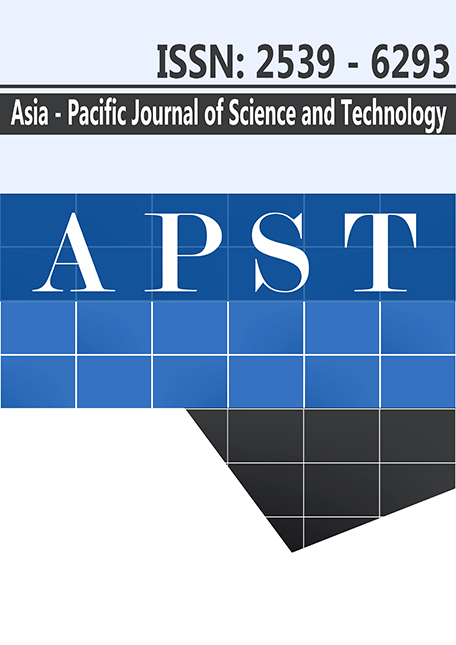Increasing calcium and dietary fiber of Mu Yo using fish bone powder and konjac flour
Main Article Content
Abstract
Fish bone powder (FBP) and konjac flour (KJF) are considered good sources of natural calcium and dietary fiber. They have a potential to improve the nutritional qualities of Mu Yo, a pork sausage. The aim of this research was to increase the calcium and dietary fiber contents of Mu Yo with FBP and KJF supplements. KJF and FBP were incorporated separately at 0.5% levels into Mu Yo. The resulting product quality was compared with a control as well as determination of the synergistic effects of using both supplements (0.5% KJF and 0.5% FBP). A reduction in moisture content was found when both KJF and FBP were added. The total ash content was significantly increased by FBP addition. Consequently, the total calcium content of Mu Yo increased from 5.5 to 191 mg per serving size (100 g). Thus, this food can be classified as high calcium product. The crude fiber and total dietary fiber were also increased (P < 0.05) when KJF was added regardless of FBP addition. Based on texture profile analysis, addition of KJF resulted in an increase hardness and adhesiveness of product. Yellowness and redness of the product were increased with addition of FBP, while a slight reduction of whiteness was found. The integrity of the gel emulsion was not affected by either KJF or FBP supplementation as assessed by scanning electron microscopy. Sensory evaluation revealed that there was no difference in consumer preference between the samples.
Article Details
References
https://en.wikipedia.org/wiki/Ch%E1%BA%A3_l%E1%BB%A5a. (accessed 27. 10. 15).
[2] Benjapong, W., Karnpanit, W., Thesasilp, J., Likhitrattanaporn, J., Visetchart, P., Moungsrichan, N., Pochai,
T., 2011. Exposure assessment of nitrate and nitrite from the consumption of processed meat in Thai
population. KKU Research Journal 16, 931-941.
[3] Jirukkakul, N., 2013. A study of Mu Yor sausage wraps using chitosan films in corporating garlic oil, lemon
grass oil, and galangal oil. International Food Research Journal 20, 1199-1204.
[4] Hamada, M., Nagai, T., Kai, N., Tanoue, Y., Mae, H., Hashimoto, M., Miyoshi, K., Kumagai, H., Saeki, K.,
1995. Inorganic constituents of bone of fish. Fisheries Science 61, 517-520.
[5] Toppe, J., Albrektsen, S., Hope, B., Aksnes, A., 2007. Chemical composition, mineral content and amino
acid and lipid profiles in bones from various fish species. Comparative Biochemistry and Physiology Part
B: Comparative Biochemistry 146, 395-401.
[6] Phiraphinyo, P., Taepakpurenat, S., Lakkanatinaporn, P., Sunthornsuk, W., Suntornsuk, L., 2005. Physical
and chemical properties of fish and chicken bones as calcium source for mineral supplements.
Songklanakarin Journal of Science Education and Technology 28, 327-335.
[7] Techochatchawal, K., Therdthai, N., Khotavivattana, S., 2009. Development of calcium supplement from
the bone of Nile Tilapia (Tilapia nilotica). Asian Journal Of Food & Agro-industry 2, 539-546.
[8] Hemung, B., 2013. Properties of tilapia bone powder and its calcium bioavailability based on
transglutaminase assay. International Journal of Bioscience, Biochemistry and Bioinformatics 3, 306-309.
[9] Hemung, B., Sriuttha, M., 2014. Effect of Tilapia bone calcium on qualities of tilapia sausage. Kasetsart
Journal - Natural Science 48, 790-798.
[10] Yin, T., Park, J.W., 2014. Effects of nano-scaled fish bone on the gelation properties of Alaska Pollock
surimi. Food Chemistry 150, 463-468.
[11] Yin, T., Reed, Z.H., Park, J.W., 2014. Gelling properties of surimi as affected by the particle size of fish
bone. LWT - Journal of Food Science and Technology58, 412-416.
[12] Shah, B.R., Li, B., Wang, L., Liu, S., Li, Y., Wei, X., Weiping, J., Zhenshun, L., 2015. Health benefits of
konjac glucomannan with special focus on diabetes. Bioactive Carbohydrates and Dietary Fibre 5, 179-187.
[13] Zhang, Y., Xie, B., Gan, X., 2005. Advance in the application of konjac glucomanan and its derivatives.
Carbohydrate Polymers 60, 27-31.
[14] Tennyson, J.M., Winlers, R.S., 2000. Fish and other marine product. In: Horwitz W, editor. Official Methods
of Analysis of the Association of Official Analytical Chemists. 17th ed. USA: Washington DC, 8-12.
[15] Davidson, M.H., McDonald, A., 1998. Fiber: Forms and functions. Nutrition Research 18, 617-624.
[16] Bennink, B.R., 1998. Fiber analysis. In: Suzanne, NS, editor. Food Analysis. USA: Aspen Publishers. 189-200.
[17] Williams, P.A., Phillips, G.O., 2000. Introduction to food hydrocolloids. In: Williams PA, Phillips GO,
editors. Handbook of Hydrocolloids. England: Woodhead Publishing Limited, 1-19.
[18] Dreher, M.K., 2001. Dietary Fiber Overview. In: Cho SS, Dreher ML, editors. Handbook of Dietary Fiber.
New York: Marcel Dekker, 1-16.
[19] Royal Thai Government Gazette., 1998. Nutrition Labeling; 1998. MOPH notification No.182, BE. 2541.
[20] Miura T, Nakano M. Calcium bioavailability of total bone extract (TBE) and its effects on bone metabolism
in rats. Bioscience, Biotechnology, and Biochemistry 62, 1307-1321.
[21] Malde, M., Bugel, S., Kristensen, M., Malde, K., Graff, I., Pedersen, J., 2010. Calcium from salmon and cod
bone is well absorbed in young healthy men: a double-blinded randomized crossover design. Nutrition &
Metabolism 7, 61-69.
[22] Sittikulwitit, S., Sirichakwal, P.P., Puwastien, P., Chawasit, V., Sungpuag, P., 2004. In vitro bioavailability
of calcium from chicken bone extract powder and its fortified products. Journal of Food Composition and
Analysis 17, 321-329.
[23] Folk, J.E., 1980. Transglutmaninase. Annual Review of Biochemistry 49, 517-531.
[24] Nozawa, H., Mamegoshi, S., Seki, N., 1997. Partial purification and characterization of six transglutaminase
from ordinary muscles of various fishes and marine invertebrates. Comparative Biochemistry and
Physiology Part B: Biochemistry and Molecular Biology 118, 313-317.
[25] Binsi, P.K., Shamasundar, B.A., 2012. Purification and characterization of transglutaminase from four fish
species: Effect of added transglutaminase on the viscoelastic behavior of fish mince. Food Chemistry 132,
1922-1929.
[26] Chin, K.B., Keeton, J.T., Longnecker, M.T., Lamkey, J.W., 1999. Utilization of soy protein isolate and
konjac blends in a low-fat bologna (Model system). Meat Science 53, 45-57.

